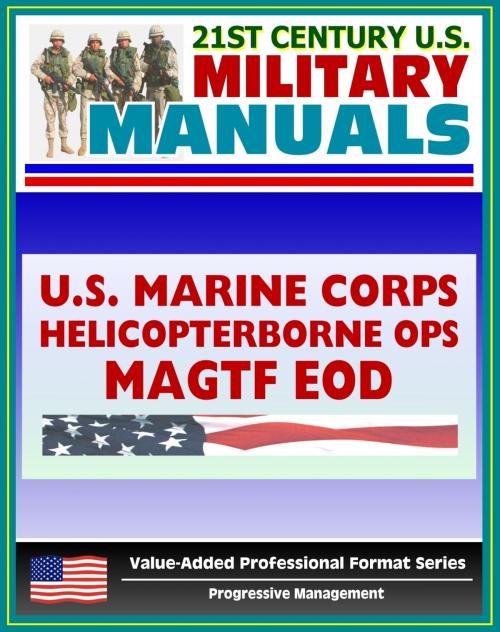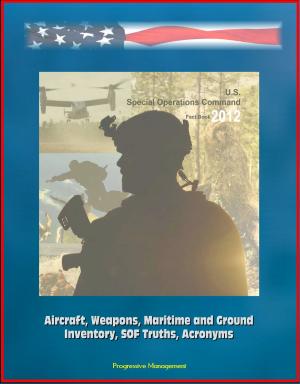21st Century U.S. Military Manuals: Tactical Fundamentals of Helicopterborne Operations and MAGTF Explosive Ordnance Disposal Marine Corps Field Manuals (Value-Added Professional Format Series)
Nonfiction, History, Military| Author: | Progressive Management | ISBN: | 9781466018723 |
| Publisher: | Progressive Management | Publication: | September 29, 2011 |
| Imprint: | Smashwords Edition | Language: | English |
| Author: | Progressive Management |
| ISBN: | 9781466018723 |
| Publisher: | Progressive Management |
| Publication: | September 29, 2011 |
| Imprint: | Smashwords Edition |
| Language: | English |
Part of our value-added professional format series, this ebook contains two Marine Corps Field Manuals: Tactical Fundamentals of Helicopterborne Operations and MAGTF Explosive Ordnance Disposal.
Helicopterborne Operations: Provides the doctrinal foundation for helicopterborne operations in subsequent operations ashore. Helicopterborne operations are those operations in which assault forces (combat, combat support [CS], and combat service support [CSS]), using the firepower, mobility, and total integration of helicopter assets, maneuver on the battlefield under the direction of the assigned commander to engage and destroy enemy forces or to seize key terrain. The most common helicopterborne operation is a helicopterborne assault. A helicopterborne assault is a landing of helicopterborne forces within or adjacent to an objective area for the purpose of occupying and controlling the helicopterborne objective area and positioning units for action against hostile forces. Helicopterborne operations are tactical movements by helicopter to support the ground tactical plan. They should not be considered merely movements of Marines, weapons, and materiel by helicopter units. Helicopterborne operations are deliberate, precisely planned and vigorously executed combat operations designed to allow friendly forces to strike over extended distances and terrain barriers to attack the enemy when and where he is most vulnerable. In essence, helicopterborne operations promote versatility of infantry forces in multiple operations. Helicopterborne operations promote the combined arms concept through coordination and planning between the air and ground commanders. This manual describes how infantry and aviation units plan and conduct helicopterborne operations according to the ground tactical plan for subsequent operations ashore. It emphasizes the coordination necessary between ground combat, CS, and air organizations concerning the planning sequence and tactical employment of ground and aviation elements. This manual is written primarily for infantry and aviation units and is applicable to combat, CS, and CSS units with a need to plan for and use helicopter support.
MAGTF Explosive Ordnance Disposal: Addresses the employment of explosive ordnance disposal (EOD) units in support of Marine Air-Ground Task Force (MAGTF) combat operations, and it provides a doctrinal point of reference for the integration of EOD tasks into MAGTF combat operations. Prior to World War II, explosive ordnance disposal (EOD) organizations did not exist. EOD disposal was handled by the person with the most ordnance experience. During World War II, Germany initiated a bombing blitz of England. By dropping bombs with long delay fuzes (delays of up to 80 hours after impact), the Germans created a continuous bombing that effectively lasted 24-hours a day. Bombs that did not explode upon impact were considered delay-fuzed until they were dug up, identified, and rendered safe. This dangerous and time-consuming job required the evacuation of over 2,200 locations within metropolitan London and greatly increased both civilian and military casualty rates. In 1940, in an attempt to prevent hazards to both the civilian populace and military operations and reduce the casualty rate, Great Britain established a corps of skilled technicians to handle unexploded enemy ordnance. The British War Office assigned EOD responsibilities to the British Army Royal Engineers and the Royal Navy. The British Army Royal Engineers' bomb disposal units were responsible for ordnance items found on land. The Royal Navy's mine squads were responsible for ordnance items found at sea; i.e., mines. Initially, many bomb disposal technicians died due to the trial and error methods of disposal. Only the officer in charge of the bomb disposal unit or mine squad rendered safe or removed the fuze from a dud or delay-fuzed bomb.
Part of our value-added professional format series, this ebook contains two Marine Corps Field Manuals: Tactical Fundamentals of Helicopterborne Operations and MAGTF Explosive Ordnance Disposal.
Helicopterborne Operations: Provides the doctrinal foundation for helicopterborne operations in subsequent operations ashore. Helicopterborne operations are those operations in which assault forces (combat, combat support [CS], and combat service support [CSS]), using the firepower, mobility, and total integration of helicopter assets, maneuver on the battlefield under the direction of the assigned commander to engage and destroy enemy forces or to seize key terrain. The most common helicopterborne operation is a helicopterborne assault. A helicopterborne assault is a landing of helicopterborne forces within or adjacent to an objective area for the purpose of occupying and controlling the helicopterborne objective area and positioning units for action against hostile forces. Helicopterborne operations are tactical movements by helicopter to support the ground tactical plan. They should not be considered merely movements of Marines, weapons, and materiel by helicopter units. Helicopterborne operations are deliberate, precisely planned and vigorously executed combat operations designed to allow friendly forces to strike over extended distances and terrain barriers to attack the enemy when and where he is most vulnerable. In essence, helicopterborne operations promote versatility of infantry forces in multiple operations. Helicopterborne operations promote the combined arms concept through coordination and planning between the air and ground commanders. This manual describes how infantry and aviation units plan and conduct helicopterborne operations according to the ground tactical plan for subsequent operations ashore. It emphasizes the coordination necessary between ground combat, CS, and air organizations concerning the planning sequence and tactical employment of ground and aviation elements. This manual is written primarily for infantry and aviation units and is applicable to combat, CS, and CSS units with a need to plan for and use helicopter support.
MAGTF Explosive Ordnance Disposal: Addresses the employment of explosive ordnance disposal (EOD) units in support of Marine Air-Ground Task Force (MAGTF) combat operations, and it provides a doctrinal point of reference for the integration of EOD tasks into MAGTF combat operations. Prior to World War II, explosive ordnance disposal (EOD) organizations did not exist. EOD disposal was handled by the person with the most ordnance experience. During World War II, Germany initiated a bombing blitz of England. By dropping bombs with long delay fuzes (delays of up to 80 hours after impact), the Germans created a continuous bombing that effectively lasted 24-hours a day. Bombs that did not explode upon impact were considered delay-fuzed until they were dug up, identified, and rendered safe. This dangerous and time-consuming job required the evacuation of over 2,200 locations within metropolitan London and greatly increased both civilian and military casualty rates. In 1940, in an attempt to prevent hazards to both the civilian populace and military operations and reduce the casualty rate, Great Britain established a corps of skilled technicians to handle unexploded enemy ordnance. The British War Office assigned EOD responsibilities to the British Army Royal Engineers and the Royal Navy. The British Army Royal Engineers' bomb disposal units were responsible for ordnance items found on land. The Royal Navy's mine squads were responsible for ordnance items found at sea; i.e., mines. Initially, many bomb disposal technicians died due to the trial and error methods of disposal. Only the officer in charge of the bomb disposal unit or mine squad rendered safe or removed the fuze from a dud or delay-fuzed bomb.















